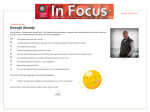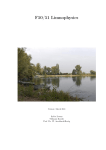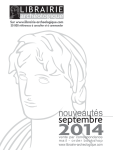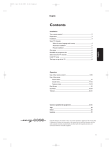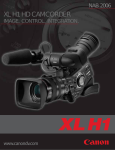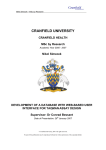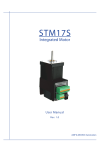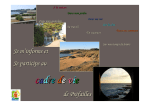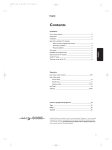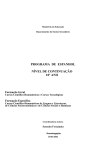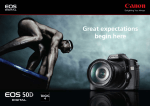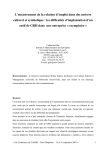Download OCC Monthly Newsletter
Transcript
Issue 2 - September 2009 Oshawa Camera Club Monthly Newsletter Contents Welcome to the second issue of In Focus. Page 2 Page 3 Page 4 Page 5 Page 7 Page 9 Page 10 Page 12 Page 14 Page 16 Page 17 Page 18 Page 20 - Presidents Musings by Valerie Slagter - Photograph of the Month by Monica Taylor - Apple Cart by Brian Greenway - Canon Connections by Brian Greenway - Club Outings by Darryl Kennedy - Creative/Abstract Techniques by Fred Sewel - Education Program Update by Monica Taylor - Frame of Mind by Bharat Mistry - Lightroom by Des McKee - The Nikon Nook by Bharat Mistry - Random Topics by Peter Tomblin - The Traveling Photographer by Brian Greenway - The Last Word by Des McKee We have a new feature this month, "Random Topics" and our first contribution is from Peter Tomblin. This is where you can go to share your ideas with the membership. If you have a photography story, a favorite photography technique or a great location or anything else you want to share, please send it to me via [email protected] and it will get published here. I am also thinking of starting a new regular column, "Ask an Expert". However, this will only work if you send in your questions. So if you have any, please sent to [email protected] Hope you enjoy this issue. The Editor The Photography Month at a glance Sept 9 - 1st club meeting. Guest speaker - Stan Bain will talk about the use of Waterglass. Sept 23 - Start 6:15 for a pre-meeting tutorial by Bharat Mistry on the rules and regulations for clinic entries. At the formal meeting, Peter Tomblin will be presenting the 2009 GTCCC competition results. This summer I took a two week road trip through the Rockies in British Columbia and part of Alberta. Around each corner of the winding roads were some of the most breathtaking sights I have seen in all my travels. Many of the mountain ranges reminded me of the Andes in South America. The saying “beauty is in the eye of the beholder” came to mind when I reviewed the many shots I took of each scene. What was captured by the camera’s “eye” had a different impact on me when compared to the actual feeling I had and what my eye saw at the time I took the shot. This made me think about how all of our senses come into play when we engage in the art of photography. It’s not just about our technical ability to create good photographic compositions. Our personal sense of good photography brings all of our discerning knowledge and emotions into play. If we are able to capture in our images all of the basic elements that we consider must be present in a “good shot”, we usually feel pretty satisfied with the outcome. Whether or not others see the same quality in the images we consider to be winners is not all that important. Our sense of accomplishment and the enjoyment we get from our creations carries much more weight in the long run than another person’s subjective evaluation. However, if we can accept the opinions of others as an opportunity to see our images from a different perspective, it can be a vital learning and motivation tool. thought to this when it comes time for us to submit our “winners” to the various clinics. After all, the clinic judges are human beings with their own set of criteria and biases and will evaluate each image based on their personal experience, knowledge and individual preferences. The number that judges assign to an image is only an indication of their personal assessment. Their comments can often help us to see the images from a different point of view. If the assigned number to an image is lower than you expect, it does not mean that you should consider it an inferior shot. It could mean an opportunity to gain a deeper insight from another person’s perspective and perhaps build a heightened awareness of your photographic style and preferences. In the words of the highly successful photographer, Ansel Adams “Simply look with perceptive eyes at the world about you, and trust your own reactions and convictions. Ask yourself; does this subject move me to think, feel and dream? Can I visualize a print, my own personal statement of what I feel and want to convey about the subject before me?” I look forward to seeing all of the wonderful images submitted to the clinics this coming season and feel very pleased to be associated with such a talented and creative group of photographers. Your willingness to participate in the planned program activities and to share your talent and expertise is what makes our club successful, worthwhile and productive. I encourage all of you to give some In Focus Issue 2 Page 2 Red Tailed Hawk by Monica Taylor Time: March 28, 2009 Late afternoon Location: Ajax Subject: Red Tail Hawk Lighting: Natural Day light Camera: Canon 30D Lens: 400mm prime Shutter speed: 1250 Aperture: F8 ISO: 200 Handheld with a shoulder brace. Nature photography is my passion, primarily birds and animals. I spend a lot of hours researching and driving around looking for that perfect subject. Sometimes you don’t see a single In Focus Issue 2 thing for days and sometimes you have that magical moment as I did this day. Red tail hawks are usually a very elusive bird. I am sure you have all seen them while driving along the highway. Have you ever tried to photograph them? Usually they will fly away as soon as you stop your car. I wanted to get that catch light in his eyes while also capturing the talons and amazing details on his back feathers. I was so excited when given the opportunity as this hawk almost posed for me! It was the most cooperative hawk I have ever encountered. Opportunities do come to those who are patient. Page 3 Assessing Apple’s Aperture: A Personal View Pt.1 Other than IPhoto, Aperture is Apples’ big entry into the Digital image processing market. How good is it? Should Mac users switch from Lightroom or even Capture One? How easy is it to learn the operating features of this application? This type of software constitutes a sizable investment so I thought it would be useful to report on my own personal experiences with assessing Aperture in the next few columns. Looking at the glossy magazine reviews and a few blogs is nothing like having your own hands-on opportunity so I installed Aperture on a 30-day trial. Most of the editors of software and media reviewers must be afraid of lawsuits because they are all so friendly and careful to point out the strengths and weaknesses of competing software and but they were consistently full of phrases like “Importing images couldn’t be easier” or “very intuitive interface.” Using Aperture should be a breeze. So after an easy install I looked forward to quickly Importing some images into Aperture and quickly into some heavy duty processing. I quickly discovered it is much different from Lightroom, not intuitive at all! When they say the interface is “Intuitive” that means to me I can use all the old habits I’ve learned over the years and don’t have to learn anything new. When I right click on a thumbnail it should list some standard actions that I know or that’s not intuitive. Intuitive also means I can by my lazy self and not have to learn any new fancy lingo or even think about reading the manual. Starting at the beginning with importing images from my camera card the display is fast and in an attractive browser format rather than a dialogue box style. Frustratingly for me however I have to put them into a Project Folder. Why does Apple persist in In Focus Issue 2 wanting to put everything in to ‘projects’ and ‘albums’? Gripes I just went out to enjoy a photo shoot and quickly want to process the images - there is no project, no album, no nothing until an idea seizes me, and wouldn’t that group of images make a great photo album or slide show. Aperture allows you to leave it untitled and even create a subfolder but the images can only go into the project folder - why then can I create a sub-folder? I have some flower images from a trip to Newfoundland -why can’t I put them straight into the sub-folder I created under the project Newfoundland called flowers? Off to the User Manual then. Ten minutes of searching later and the term “intuitive” is beginning to rankle somewhat. There seems nothing to fit the bill but I begin to realize that Aperture separates the storage function of importing files (naming files/Hard-drives/folders/sub-folders, etc) apart from the Project/Album/Book/Light table system which is a major part of Aperture. The subfolder created in the project system is not related at all to the file’s folder destination on the hard-drive. So much for “intuitive interface” and “importing images couldn’t be easier”, its back to more tutorials, manuals and right-click menus. The problem, I realize is that I come from a Windows/Lightroom experience and see the new software as a variant of that experience rather than something new and requiring a different mind set, in this case the Apple-image management mindset from Iphoto. Because I have no experience with the projectsand-albums approach I’m already confused and unhappy with the software, but for most of us that is how we do come to a new situation by using our past experiences. I have learned this software evaluation is a task fraught with pitfalls and bias -I vow to calm down and be more objective. Page 4 now provided sets of these adjustments called “PIcture Styles” which have been based on the experience of photographers. The pre-set styles are Standard, Portrait, Landscape, Neutral, While all those photons of light are “cooking” in the camera sensor they can either be left alone Faithful, and Monochrome. Usually Canon throws in 3 user-defined custom settings too. (RAW), or processed to create a JPEG. Most And, even more styles can now be downloaded Canon DSLRs starting with the model 10D onwards have let the user adjust this processing and installed...anyone for Nostalgia, Emerald, or Autumn Hues? using four main “Image Parameters” (sharpness, contrast, saturation and color tone). Here are the Canon descriptions of the 6 basic pre-sets: Later models 40D, 450D, 5D, and 1D’s have PIcture Styles - Are these really useful? In Focus Issue 2 Page 5 To see examples and get a more detail with a dynamic explanation see: http://www.dpreview.com/reviews/canoneos5 d/page14.asp or Canon’s site at http://www.usa.canon.com/content/picturest yle/viewers/index.html, or http://www.canon.co.jp/imaging/picturestyle/ style/neutral.html. Picture styles do not affect RAW files and those who are comfortable with post-processing may not feel the need for using them at all. For my eye, other than Monochrome, the different styles are hardly distinguishable. The difference between neutral and faithful is particularly confusing. The in-camera settings are identical yet Canon’s Japanese site says the saturation is lower in Faithful and the colours are more accurate. Is that, therefore, a factory setting that cannot be adjusted in the camera? Because these image parameters, including the pre-sets, can be user-adjusted and if you are shooting only JPEG files then the Picture Style option can be a useful tool in obtaining the style of images you prefer. Experiment with your cameras styles and see if there can be significant differences in your images. As Canon says, its analogous to choosing the various types of film qualities available such as Ektachrome, Velvia 100 or Fuji Provia. On the other hand is Canon selling something more supernatural, for example, their Twilight Style “Affords a magical finish to the entire photo.” That’s what my images definitely need - more magic! Wolf by Monica Taylor In Focus Issue 2 Page 6 Confirmed Outings – 2009 /2010 Season On this special day, there will be the usual activities including spinning demonstrations, baking demonstrations, wood stove demonstrations, blacksmith demonstrations, gardening demonstrations, kids dress-up, rural runway fashion show, and hay rides. There will also be a host of fundraising activities. Hours & Rates Open from 12 noon until 4 pm Admission is FREE Location Bowmanville Zoo , “ Sat. Sept. 19, 2009 2365 Concession Road #6 Pickering, Ontario “( Rain Day Sunday ) Bowmanville Zoo has over 300 creatures including many famous animal celebrities. Hours & Rates September 10:00 a.m. to 4:00 p.m. Weekdays ( Weekends 10:00 a.m. to 5:00 p.m. ). P:905.683.8401 Crawford Lake Conservation Area ( Niagara Escarp.) ,“Oct. 17 , 2009” Showtimes at 12:00 , 2:00 and 4:00 pm ( mainly on weekends ) Carnivore feeding at 3:00 pm ( mainly on weekends ) Adults ... $18.50 Seniors ... $15.50 Groups of 10 to 35 people … $15.00 per person The pristine waters of Crawford Lake have drawn people to its shores for hundreds of years. The rare lake, with surrounding boardwalk, is nestled in lush forests atop the stunning Niagara Escarpment where visitors can watch soaring turkey vultures glide through the Nassagaweya Canyon. You can even step back Location: 40 King Street East in time and explore the 15th century Iroquoian Bowmanville, Ontario, L1C 3K5 Village that has been reconstructed on its original site. The spirits still sing in the rustic P:905.623.5655 longhouses where tools, animal hides and the smell of smoke let you experience the life and times of Ontario’s First Peoples. Crawford Lake Facts - 468 hectare park established in 1969 on the Niagara Escarpment in Milton - Regionally Environmentally Sensitive Area - Provincial Area of Natural and Scientific Interest - World Biosphere Reserve as part of Pickering Museum Village – Family Niagara Escarpment th - Rare meromictic lake with surrounding Day, October 4 , 2009 ” (NO Rain Day) boardwalk Take a step back in time and enjoy what history - One of the most accurately dated prehas to offer. With an impressive range of events the possibilities are endless at Pickering contact archeological sites in Canada Museum Village. This award winning village has - 15th century reconstructed Iroquoian fifteen restored heritage buildings which Village and heritage site comprise a quaint pioneer village, including a blacksmith and wood shop, general store, - Nassagaweya Canyon Interpretive Lookout schoolhouse, houses, barns and churches. In Focus Issue 2 Page 7 - 19 km of hiking and cross-country skiing and snowshoeing trails with connections to Bruce Trail - Elevated boardwalk with interpretation stations surrounding Crawford Lake - Education programs and exhibits - Visitors Centre and Gathering Place facilities with Gift Shop, theatres, lunchrooms, exhibits, displays and outdoor picnic areas Hours & Rates north of the Q.E.W. GPS Coordinates: 43.47 -79.951 P:905.854.0234 Customer Service: Extension 221 Summary of Proposed Outings for the remainder of the season Brickworks ,“Late Oct. / Early Nov. 2009” Distillery District (Gooderam & Worts), “Late Nov. / Early Dec. 2009” Open All Year! Crawford Lake is open weekends and holidays (closed Christmas Day) all year long and daily May to October. Open at 10 am to 4pm daily. *Note: with the exception of July & August, weekday services and facilities are limited. Please contact the park prior to your visit for details (905) 854-0234. Canadian Automotive Museum, “Jan - Feb. Adults ... $ 6.50 Seniors ... $ 5.50 Kensington Market , “April 2010” Location Driving Directions: - Crawford Lake Conservation Area is located at Steeles Avenue and Guelph Line, 5 km. south of Highway 401 and 15 km. Northwood Zoo & Animal Sanctuary, “Late May 2010” Baps Shri Swaminarayan Mandir, “Mar - Apr. 2010” Riverdale Farm , “Mar - Apr. 2010” Black Creek Pioneer Village, “Early May 2010” 2010” The Guild, “Early June 2010” Summer Lily by Brian Greenway In Focus Issue 2 Page 8 LIGHTING EFFECTS using Elements 4. An average image may just turn out to be a gem. If you have ever just wanted to have some fun Lighting Effects is just the answer. It can change an ordinary image into something exciting; it can give a lift to a flat image. The following effect is best done with an image that has texture. ie. wood door, barn, straw, brick or stone. STEP 1:- As always before you do anything make a working copy of the original image. While this could be in JPG format, it is much better to use Tiff. For use on Flowers and Portraits omit steps 5 to 8. Try some of the other lighting effects; you just may have an image you can use them on. Remember, have fun. STEP 2:- Select the working copy you just made, then select FILTER> RENDER>Lighting Effects. STEP 3:- Click Default then select Flashlight. STEP 4:-select light type OMNI. STEP 5:- Set the intensity to approx. 50, (try different settings to see what they produce). Then locate the light to the desired position (the one third points generally work well) and adjust the size of the circle. STEP 6:- On the texture select ie, Red - also try the others. STEP 7:- For the height I have found 50 to be a good start but every image can be different so try other settings. STEP 8:-Once you have it the way you want it Click OK, then Save it. In Focus Issue 2 Page 9 How fast time passes by. It’s September and we are ready and excited to have our first meeting of the season!! I hope you have all been out shooting this summer. We look forward to all of your images. I have provided the information for October’s program so go ahead and mark these on your Calendar. October 7th, 2009 meeting: October promises to be another informative month. We start with a live clinic judging. We have three of our local judges including one of our own, Vern Mossey coming out to a mock clinic. This is a great opportunity for you to witness the process of judging for our clinics as well as what judges are looking for in your images. The pre-tutorial will be presented by Des McKee. Des took his first picture in 1955, using a Kodak Brownie camera owned by his father. By 1963, he had purchased his first 35mm camera and by 1968 was developing and processing B&W prints and colour slides. He and his wife moved to Canada in 1974 where he continued his interest in photography. He purchased the first of many digital cameras in 1995 (a 0.24Mpixel camera). He bit the bullet and got rid of his 35mm film cameras in 2004. Digital photography also ties well into his other hobby; that of building and In Focus Issue 2 playing around with computers. He is mainly interested in the technical aspects of photography and in airshow and aircraft photography. He joined the Oshawa Camera Club in 2006 and under the influence of other members, is branching out into nature, portrait and wedding photography. This tutorial is on shooting Raw and the benefits. For those of you who are still shooting jpeg this will be especially beneficial for you. Des has done many tutorials for the club in the past and I think you will all agree, he has always been informative and inspiring. Start time is 6:15pm October 21st meeting: The very first clinic of the season! Bharat Mistry will host this meeting. It is always an entertaining evening. This is a wonderful chance to see some of our members’ images as well as the opportunity to encourage each other. With the judges’ comments and critiques, you can also learn how to take better images. Today’s pre-tutorial will be presented by Nick and Sharon Janishewski. Nick’s photography history is short, he started in 2004. To catch up to the OCC talent, he took three workshops with Craig Tanner: Next Step, Tetons and Death Valley. Three with Rocky Page 10 Mountain School of Photography, Nova Scotia, Light Studies and Art of Macro and one with Mark Johnson in Washington. More are planned for 2010. He was a team facilitator in 2008 where he started to learn ProShow Producer. He also photographs stage productions for ACT One in Pickering, Wardrop Engineering events, did a wedding and does volunteer photography in the community. Nick hasn’t developed a preference for a style of photography and is open to new directions. He has become fairly proficient in Photoshop but likes to minimize its use. He has retired from Ontario Hydro’s Protection and Control in 2000. But still does consulting work for Wardrop Engineering (where he designed more than half the windfarms in Ontario) he continues to design independently and implement the SONET system in Markham’s PowerStream to support Sharon’s and his photography habit! For several years, Sharon’s husband Nick encouraged her to join him in his passion for photography. In April 2008, shortly after she got her first Digital SLR camera, he enrolled her in a Women’s Foundation Workshop in Savannah, GA where she was able to learn photography basics. Additional workshops to practice her newly learned skills followed with Nova Scotia Fishing Villages with Rocky Mountain School of Photography (RMSP), The Grand In Focus Issue 2 Tetons with The Mindful Eye, The Vibrant Colours of Skagit Valley and Butchart Gardens with Mark S. Johnson Photography; Light Studies: The Light and Atmosphere of Place and The Art of Macro with RMSP. Future workshops include Zion National Park with The Mindful Eye and England’s Lake District with The Digital Dawn. In addition to the workshops, she and Nick will join photography friends in Newfoundland and Colorado in 2010. What better way to see the world, but through the lens of a camera. Sharon joined the Oshawa Camera Club in September 2008, participating in Club outings and clinics and is a Team Facilitator for 2009-2010. For a second year, she will be a volunteer photographer for Whitby in Bloom. Sharon is a retired Medical Laboratory Technologist, who volunteers as secretary and director of the Vasculitis Foundation Canada. When not away taking workshops, she likes to spend time with her three grandchildren. The pre-tutorial for this meeting will be on High dynamic range in Photomatix . This is an amazing software package that I am sure you will be enticed to try. This is a great way to enhance some of your images. Nick and Sharon will share their knowledge and tell us what images work best and how to get the best out of them. Start time is 6:15pm Page 11 Moments of Awe I’m sure you’ve had moments during your day where you’ve wished you had a camera to capture a subject or an occurring event. It just seems natural for us as humans to document certain things that intrigue us. But what about a time when the camera was the last thing on your mind? I’m not talking about everyday routine events, but something that stops you dead in your tracks and leaves you totally mesmerized that even if you did have a camera in hand, you were unconcerned with it in any way. These I call having a “Moment of Awe”. To define this phenomenon, they are usually a first time experience or occurrence and sometimes take you off guard. For example, witnessing the birth of your first born, (second one, not so much!), peering over the Grand Canyon for the first time, watching the sun break over Machu Pichu or even something grisly as a car crash unfolding before you – in all instances, it’s individually relevant to you and may seem ho-hum and trivial to another. In any case, your body is in such sensory overload that it goes into a somewhat state of shock and the camera becomes just an after-thought. Why? Well, I bet you that you don’t experience these moments often – maybe a handful of times over our lifetime. And I also bet that you can recall each and every one of these “Moments of Awe” In Focus Issue 2 with amazing clarity and detail – just as if you were looking at a photograph. The memory of it has been etched into your mind that nothing will erase it. I was lucky enough to have two of these Moments of Awe a few years back while Scuba diving in Hawaii. On our first dive, we were drift diving a drop-off at about 40 feet. Visibility was clear on the shallow side on our left, but faded into the dark blue depths on our right. I was observing and photographing the various marine flora/fauna as we went along – many for the first time. The Dive Master points to the right and as I look over, like a ghost from the depths emerges a Giant Manta. It glides by the group, its 14 foot wingspan undulating effortlessly through the water. I can still picture its eye as it went by us. And just like that, it vanishes into the blue. The whole event lasted maybe 10 seconds, but I was pretty certain I had stopped breathing. Camera clutched uselessly at my side – 0 frames shot. The second Moment of Awe occurred on a latter dive the same day. I was descending down at about 60 feet and I’m distracted by a series of unfamiliar clicks. I look around in time to catch a pod of wild Spinner Dolphins come into view. Once again, totally hypnotized by the sight. Somehow I did manage to remember the camera and get off 3 shots before they disappeared into the blue. I still remember the baby flipping upside down and swimming under its mother’s belly. Even if I hadn’t taken any shots, I don’t think I Page 12 would have mind. Sure I’ve seen Manta and Dolphins before in print, TV and at Aquariums, but this was something else. I don’t know what it is, but it kind of shocks you on an emotional and spiritual level. We did see more dolphins and Manta rays later on, but the connection wasn’t the same as that first time. Sort of reinforces my theory that these moments are rare per person. So next time you come across a situation that leaves you awestruck and muttering Holy @*$% under your breath, be grateful of your Moment of Awe. If you should be lucky to capture it on camera, great. But if you don’t, I don’t think it matters as you’ve captured it within you and no virus, hard drive crash or computer meltdown can erase it. Think Different-ly and Discover the Possibilities. Cheers, B. Spitfire Mk 18 by Des McKee In Focus Issue 2 Page 13 Why would you want to start using Lightroom? You have been taking and processing digital images for a while now and your current set of software tools work for you. You may be using Adobe Bridge, Adobe Camera Raw and Photoshop CS or Elements and/or some other combination of tools to import your images, catalog and reference them, browse for a particular image, process the pixels, print an image or create a slideshow or upload them to the web. You have a routine (or workflow) worked out that suits you. Why would you change it now to use Lightroom? Lightroom was designed from the ground up for the digital photographer, so once you understand the Lightroom paradigm; it is very logical and easy to navigate around. There are no extraneous features, no hidden commands and no dead ends. I think that there are five main reasons why everyone should be using Lightroom. There are: 1. Lightroom’s ability to give photographers a totally integrated program, from importing, organizing, editing and sharing is unmatched by any other program (I think it’s even better that Apple’s Aperture). 2. Lightroom is designed for speed and efficient processing 3. Lightroom uses a database to file and store metadata about your images, thus making it easier to find a particular image (even if you have many thousands of images). I currently have close to 50,000 images in Lightroom. 4. Lightroom was designed to make RAW processing an easy, integrated part of your workflow. In Focus Issue 2 5. Lightroom used non-destructive processing When you start Lightroom for the first time, it may appear bewildering. Where do you start? Basically, you work from left to right and top to bottom. Fig 1 shows the opening screen for Lightroom. On the top right are the five major modules within Lightroom: Library, Develop, Slideshow, Print and Web. I think these are self explanatory but I will highlight the major functions within each module. Library Module: the library is where you will tend to start and end your Lightroom session. Common tasks are: importing images as well as exporting the finished product, keywording and metadata entry, file moving, deletion and renaming and finding, sorting and grouping images. Develop Module: this is where you do your image processing such as: white balance adjustment, contrast and colour adjustment, cropping, tonal adjustments and camera and lens adjustments Page 14 Slideshow Module: as the name implies, this creates a presentation of your images and allows you to: select images, adjust slideshow layout, adjust slideshow transitions and add music. Print Module: here you create layouts and print packages, use output-specific colour profiles and print to a local printer or print to a JPG file. Web Module: this allows you to get your images online very quickly by letting you chose from various photo gallery styles, configure the look and feel, and upload directly to your web server. All modules have a common interface, as can be seen in Fig 1. This shows the Library module components: Along the top is the Menu bar for all the commands in each module. Below this is the Module Picker to select the module you want to work with. On the left is the Left Panel group. The contents vary with each module but generally involve accessing, grouping and previewing images and templates. The Right Panel group is naturally on the right of the screen. The contents here also vary with each module but generally you find controls for adjusting and tweaking. Between the right and left panels is the main image. Underneath this is the Toolbar, where again the contents are specific to each module. Finally, along the bottom of each module is the Filmstrip, which displays thumbnails of the image grouping you are working on. At the top of the film strip, is a row of tools that you will find yourself using alot. Next issue, I will explore the Library Module in greater detail. Bee-Ready by Brian Greenway In Focus Issue 2 Page 15 To VR or not to VR & Getting Gridded! Given the plethora of features that manufacturers are bent on squeezing into the current set of cameras (Don’t get me started on Video on SLRs!); there are some features that are actually beneficial for shooting. The first one, VR Lenses (Vibration Reduction) or Image Stabilization in some form or another. The benefits that this provides is a given – ability to shoot handheld at a few stops higher than without VR. Always a plus in lowlight shooting and allowing you to get away without using the tripod or flash in certain situations. So what is the best way to maximize the VR benefit? You’ve probably noticed the set of switches on the side of your VR Lense. You have VR On/Off which is pretty obvious but you also have Normal/Active. (The other M/A-M switch is for the focusing mode – Auto or Manual) For Hand Held shooting, VR is set to ON. If you’re using a Tripod, set VR to OFF. Normally the VR expects camera motion, but when tripod mounted there is no motion so the image stabilization actually causes a jitter thus defeating the purpose. (It’s in the manual, which you read, right?) So that leaves us with the Normal/Active Switch. Very Simple – When Handheld, with VR ON – Set it to Normal if the Subject is moving and You are stationary. In Focus Issue 2 Now if You are moving, such as on a boat, car, swaying bridge or anything unstable – set it to Active. This lets VR compensate for your motion. Easy Huh. Next, let’s talk about Grid Lines. If you haven’t turned on the Grid Line feature on your camera, I encourage you to do so and leave it on. This will provide a number of benefits that I’ll explain. The clinic judges are always commenting on tilted horizons or leaning buildings and now with the gridlines, you have additional reference lines that allow you to line up your shot precisely – vertically or horizontally. The second benefit of the Grid Lines is a compositional aid. On some cameras, the grid lines are already set into thirds which is ideal for composing to the Rule of Thirds. Some like the above from a D300 are set up in a Quad grid with a viewing proportion of roughly 4” x 6” and follows pretty close to composition on the Golden Mean (1:1.5 vs. 1.6). All you have to worry about is to get your key elements to line up at the internal intersections of the four corners and the picture magically looks balanced. You will also notice, that in dim lit situations, the grid lines change from black to glowing red to help you out. Got a question about your Nikon? Send it in and I’ll do my best to answer it. Cheers, B. Page 16 Early Morning Photography by Peter Tomblin has been up for more than an hour or so. Such a mist adds considerably to the beauty of many landscape and nature pictures. Also many things, especially plant life, spider's webs and Have you noticed that almost all the like will be enhanced by tiny beads of dew. the best outdoor photographs are taken in the Real dew is quite different in appearance from early morning or in the late afternoon, that is, within a couple of hours of sunrise or a couple of the water droplets which some people apply with hours of sunset. The photographer who doesn't a spray bottle. (Yes, I admit I have done it myself!) get up with the dawn, or doesn't go out when Most of us tend to take the majority everyone else is eating dinner will seldom get of our pictures on vacation trips and the difficulty those winning shots. that arises then is the impractibility of waiting for There are a number of reasons the right time of day to take your picture, why this should be so. The first that comes to especially if one is traveling with a non mind is the angle of the light. The low angle at photographer partner. I find more and more that I which the suns rays strike the surfaces of the take my best pictures when my specific purpose subject are ideal for bringing out texture or for is to take pictures, and travel pictures are just backlighting. Leaves, petals, fur, hair are all travel pictures, not potential prize winners. The improved by backlighting, while wood, brick, best photo opportunities arise when I can set my sand, shells, skin all have textures which are alarm clock for 5 a.m. and go off alone or with enhanced by low angle, oblique lighting. Then there is the colour of the light, one or two like minded fellow photographers, who don't mind if you take an hour setting up what scientists refer to as colour temperature. one shot, or if you want to wait for the sunlight to Morning and evening light is softer, often pinker be at just the right angle before you release the than midday light and will bring out the delicacy shutter. Then when I travel I can think of the of subtle colour differences in your subject. You might also explore the differences between early pictures I take as records of a holiday. Of course when taking this approach one may still come up morning light and late afternoon light. with a potential competition shot in your travels. As well as the colour of the light, I have frequently said to beginner there is a big difference in the intensity of the photographers that one of their most important light between sunrise and midday. On a sunny accessories is a waste paper basket. I would day the brightness of the sun will give you a range of contrast between highlight and shadow add to that another important piece of that may well be beyond the ability of your film to equipment, that is an alarm clock, so that those precious spring mornings are not lost and you record. In that case your exposure will not be able to record detail in the darkest shadows or in can be out there producing masterpieces. Dress warmly, take a Thermos, double check your the brightest highlights. equipment and sally forth. You will not be Photographers who are up at the disappointed. crack of dawn will often find a soft mist over the landscape which will not be there when the sun Methought I heard a voice cry no more - (Macbeth) In Focus Issue 2 Sleep Page 17 What is the best companion camera for the Traveling Photographer? Really, after lugging around your DSLR and its accompanying lenses and gadgets for a couple of days in a new city (or any place) it starts to become a little tiring. The black monster can also be pretty intimidating to people, awkward for a candid street scene or for a social evening out. The DSLR can even generate some local hostility in some museums or historical sites as you may be competing with their own souvenir sales. At some places extra charges are made for DSLRs and even tripods. Perhaps a small companion camera is needed in addition to your DSLR. Is a pocket size point and shoot the answer? Well maybe not for some serious image-making. The compact super zooms like the Canon SX200 are really light and versatile but lack image quality ( high noise ), wide angle ability, and RAW. Maybe a step up to a higher-end compact camera is better choice. Dpreview calls these the “Enthusiast Compacts” and they did a good review of several in a group test just last December. (See http://www.dpreview.com/reviews/Q408enthusias tgroup/ ) such as Nikon’s P6000, Canon’s G10, Panasonic’s LX3 or the very new Richo GRIII are light, small, uncompromising on quality, have lots of control features, a good lens, and have that all important enthusiast’s requirement - RAW file capability. cameras in addition to their regular gear as a sort of companion or second camera. For the Traveling Photographer too, they maybe the best walk around camera to travel with when the DSLR is just too much and the control and quality of the compact super zooms are not enough. Panasonic’s LX3 took a new path, by eschewing the conventional mega-pixel race of cramming more and more of them on to the same size sensor they kept the pixel count comparatively lower to give better low-noise images - (max ISO 6400) ; and also providing a super fast f2.0 - f2.8 lens with 24 mm equivalent wide-angle capability they created quite a buzz in the photographic community. Of the 7 cameras tested by Dpreview in this group the LX3 was rated the “best of the bunch” for image quality in low light and tied with the Canon G10 in outdoor light. Dpreview rated it the overall winner against the other cameras in the category. This rating has certainly been validated by the praise in the photography podcasts and blogs where people have raved about it’s quality. On a note of caution, however, they all agree the 60 mm limit to the zoom can be a major disadvantage in many situations and this should be given careful consideration. The ability to capture your travel images in RAW gives you lots of room to make adjustments under sometimes difficult lighting situations and avoid the strong noise, over-sharpening, and automatic colour corrections built into many point and shoots and super-zooms. What the premiums lack in resolution, zoom, and lens quality, compared to the DSLR, is compensated for by their compact size, light weight, considerable depth of field and wide angle possibilities. Its not surprising, then, to discover that many top flight professional photographers use one of these high-end In Focus Issue 2 Page 18 All this buzz convinced me to part with my trusty G9 on Craig’s list and purchase the LX3. At the moment the LX3 , compared to the Canon G9 or G10, in my mind it is the ideal , carry- anywhere camera for the travel photographer who wants great image quality for close-ups, street scenes, and landscapes in a very small package. It certainly has lived up to the hype. To further reinforce the idea this is a travel camera you can set in-camera start and end “vacation dates”, along with world times for overseas travel destinations. You record them, along with the name of the location, when you take the picture. My wife takes a lot of indoor pictures at club and church meetings photographing groups in low light. The extra fast and wide angle lens was perfect for these types of situations and she discovered a very successful feature which Panasonic calls “Intelligent Auto Mode.” Effectively the camera detects if its looking at a portrait, scene, or macro situation in night or day situations and adjusts accordingly. Any of these enthusiast compacts such as Canon’s G10, Nikon’s P6000 (even has GPS) or the Panasonic LX3 with its rich feature set and RAW, would make the ideal family travel companion camera to the mighty DSLR. So good, in fact, it could be the only camera you take. --------“Fiona” LX3 switched to “Portrait” mode automatically. 1/1000 @ f2.0 ISO 80 by Joan Greenway “Waiting at #42 Charles De Gaulle” Panasonic LX3 - 1/25 @ f2.3 - ISO 400 auto Big Cat by Des McKee In Focus Issue 2 Page 19 Dawn Patrol by Des McKee Oshawa Camera Club email: [email protected] web: www.oshawacameraclub.ca Time: Jan 19, 2007, 8:29am Location: CFB Cold Lake, Alberta Subject: CF-18 Lighting: Natural Day light Camera: Canon 20D Lens: 28-135 IS Program Mode Shutter speed: 200 Aperture: 7.1 ISO: 400 Handheld. Aviation and aircraft have always been my top choice for photography. My son and I used to go to all the airshows together, now I go on my own. This photograph was taken at Canadian Forces Base, Cold Lake in Northern Alberta in mid January. (Temperature was a cool -30 degrees). We were there to watch our son graduate from the CF18 training program (did you see Jetstream on the Discovery channel?) as a fully qualified fighter pilot. As we were bring laid into the main building, I saw a door leading out to the parking area and looking out, took this image. Of all the images I took that day (>2000), this is my favorite and seeing it brings back to me how proud I am of my son and his chosen profession. The Oshawa Camera Club is now in its 72nd year of continuous operation. It serves the photographic community of Durham Region and the surrounding area. We meet on the second and fourth Wednesday of each month at 7:30 pm, from September to April, at the Northview Branch of the Oshawa Public Library, which is located at the northwest corner of the intersection of Beatrice and Ritson Road in Oshawa. Visitors are always welcome at our regular meetings. This newsletter would not be possible without the time and effort put in by a very talented team of photographers and writers. A special thanks to Bharat Mistry at q-vision who developed the graphics used throughout this newsletter. Published by Des McKee on behalf of the Oshawa Camera Club. Email questions and comments to: [email protected] The articles and photographs in this newsletter are copyrighted and are not to be reproduced or modified without the creator's written permission. For more information or a release, please contact the editor at: [email protected]




















